Argyll Ferries’ Gourock-Dunoon service has been transferred to publicly owned Caledonian MacBrayne (CalMac) following a decision by Transport Scotland to incorporate the Argyll Ferries service into the existing Clyde and Hebrides Ferry Service contract at the end of 2018. As part of the takeover, Transport Scotland has indicated improved harbour facilities for passengers will be considered in the future, including the possible introduction of electric vehicle and electric bike hubs at both ferry terminals, as well as developing the ferry service to encourage users. The ferries Ali Cat and Argyll Flyer were to be rebranded January-March to minimise service disruption.
Bournemouth Swanage Motor Road and Ferry Company’s chain ferry Bramblebush Bay resumed service on 28th January on a reduced 30-minute schedule following prolonged repairs after a hydraulic failure shortly after returning from refit at A&P Falmouth prior to Christmas.
Caronte & Tourist and their new 30% shareholder, Basalt Infrastructure Partners, jointly announced on 15th January a new 5 year business plan which is expected to bring five new ships into the fleet The investment required is worth some €300 million with €60 million coming from the Sicily Region for a pair of small ferries. Around €240 million will be provided by Caronte & Tourist for the ordering of three new ferries and a further €20 million is to be invested in the existing fleet. The company has also ordered a sistership to the 8,778gt/2018 built Elio, a double-ended ferry constructed by the Selfine Shipyard in Turkey.
CLdN RoRo cancelled a contract with Croatian shipbuilder Uljanik for the construction of one 5,500 lanemetre Ro-Ro vessel (Hull No. 531) on 27th January. The cancellation has taken place due to Uljanik’s inability to deliver the newbuilding in line with the conditions stipulated in the agreement.
The financially-troubled Uljanik is being hit with contact terminations amid the ongoing restructuring process. The shipbuilding group, which comprises the 3. Maj shipyard in Rijeka and the Uljanik shipyard in Pula, is seeking one or more strategic partners that would inject fresh funds into the company, helping it stay afloat. Brodosplit and Fincantieri have made offers for the beleaguered Uljanik outfit. The company’s 5,000 lanemetre capacity and 50,443gt newbuild Laureline was delivered from the Hyundai Mipo Dockyard (HMD) in January, the first of four sister ships due this year.
Condor Ferries’ 5,007gt/1997 built Condor Rapide arrived at Falmouth for dry docking on 14th January. Just prior to this, Condor’s chartered 7,606gt/1998 built Ro-Ro back-up vessel Arrow arrived at Poole for lay up on 11th January whilst on standby. She was again acting as winter relief vessel, as she had done in 2017-18, and tied up at New Quay South.
DFDS welcomed its largest ever Ro-Ro newbuild into the fleet on 31st January at the Jinling Shipyard in China. This means that the first of these six 6,700 lanemetre capacity ferries would soon be ready to be deployed onto the Turkey-Trieste service. Alas the ship’s name had not been released at the time of writing. The 31,356gt/1986 built Newcastle-Ijmuiden ship Princess Seaways arrived at Klaipeda on 7th February 2019 to begin 6 weeks of refit cover on the Klaipeda-Karlshamn service, covering for the 25,675gt/2009 built Victoria Seaways and 25,263gt/1999 built Optima Seaways.
The MAIB announced at 14.00 on 21st January that it was investigating a close quarters incident that was reported on 6th November 2018 between the 30,285gt/2001 built Stena Superfast VII and a Royal Navy submarine, which was operating at periscope depth.
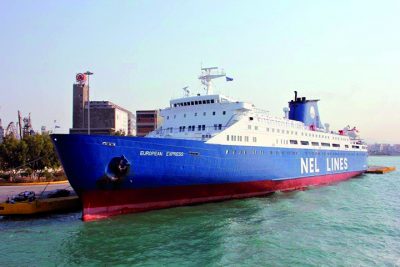
NEL Lines’ long withdrawn and laid up 15,074gt/1974 built European Express (above) was towed by the tug Christos XXII from Perama on 27th January bound for the beaches of Aliağa.
Norled AS signed an agreement in January for the construction of the world’s first hydrogen-electric ferry. The newbuilding is expected to become operational in 2021, connecting the national road 13 between Hjelmeland-Skipavik-Nesvik in Rogaland. The zero-emission ferry will be able to carry 299 passengers and 80 cars. Norled won the development contract in competition with Fjord 1 and Boreal. The contract includes the development, construction and operation of the ferry where at least 50% of the energy requirement is covered by hydrogen.
P&O Ferries’ 47,592gt/2011 built Spirit of Britain resumed service on 14th January after refit at Blohm+Voss, Hamburg. Sistership Spirit of France then went to Hamburg for her refit. Sadly, both ships are now registered in Limassol and the remainder of the P&O Dover fleet is also being transferred to the Cypriot Shipping Register from the U.K. Forthcoming changes relating to Brexit are being blamed.
Ports De Normandie has been formed by the Ports of Caen-Ouistreham, Cherbourg and Dieppe joining forces. Caen-Ouistreham and Cherbourg were already united as Ports Normands Associés (PNA) but Dieppe has now been added and the name of the ports group changed. Together, the three ports have six ro-ro berths, and handle some 200,000 freight units per year via DFDS (Transmanche Ferries), Brittany Ferries and Irish Ferries.
Port of Felixstowe and DFDS have agreed to increase Ro-Ro capacity at the UK port by over 40% through investment in a new linkspan, tractor units and additional trailer parking facilities for 300 units. Demand on DFDS’s service to Rotterdam has been growing steadily for a number of years and a new 15 year contract has been signed.
Seaborne Freight’s multi-million-pound contract awarded by the UK Government to operate additional freight services by using the Ramsgate-Ostend route has been cancelled. The company’s lack of ships or operational experience did attract much ridicule when first announced and showed a total lack of research by those in charge of the contracts. Other featured operators such as Brittany Ferries do already have schedules in place to offer the extra sailings but Seabourn still had no ships by the time their contract was withdrawn. Arklow Shipping has been highlighted as a backer of Seaborne Freight, and they have apparently withdrawn that backing.

Société des Traversiers du Québec (STQ) has acquired the 6,609gt/1970 built Apollo from Woodward Group’s Labrador Marine Inc. for (€.39 million). Prior to the Apollo being ready for STQ, the CMTA Voyageur was employed on the Côte-Nord-Matane link on 2nd February. The Apollo was expected to enter service on 13th February once the berths at Baie-Comeau and Godbout had been adapted.
Kvarken Link has signed a Letter of Intent with Rauma Marine Constructions (RMC) for a €120 million hybrid gas-powered Ro-Pax ferry with capacity for 800 passengers and 1,500 lanemetres of freight. The ship will serve the Bothnian Gulf route between Vaasa and Umeå.
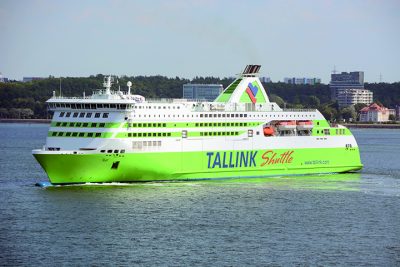
Tallink’s 36,249gt/2007 built Star (above), which operates on the Tallinn-Helsinki route, completed a comprehensive refit at the Klaipeda shipyard in Lithuania in January. The ship received examples of the innovative EnergoProFin equipment, fitted on the propellers, which is intended to increase efficiency and reduce energy loss and underwater noise by way of an additional propeller with small rotors. The refit also encompassed the Snack Time cafe and Starbucks Café, the Sea Pub has been revised, the children’s play area and shopping areas received a facelift and new carpets were fitted in key areas. The Star returned to service on 22nd January in partnership with the 49,134gt/2017 built Megastar. The 48,915gt/ 2009 built Baltic Queen and 48,915gt/2006 built Galaxy were next to receive their overhauls with the 40,975gt/2004 built Victoria I and 35,154gt/1989 built Isabelle scheduled for the same attention in spring 2019.
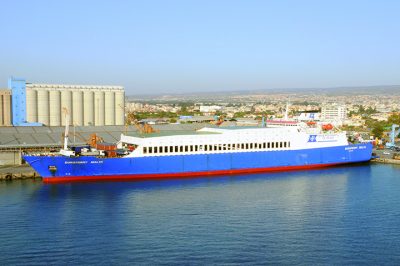
Grimaldi Group has sales-listed the 21,664gt/1995 built and 1,960 lanemetre capacity Euroferry Malta (above) and Eurocargo Napoli. Adria Ferries has also put the 19,811gt/1979 built AF Francesca on the market. This Ro-Pax offers capacity for 2,000 passengers and 850 lanemetres and has 290 cabins.
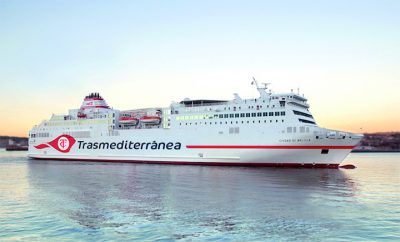
Trasmediterranea’s 26,916gt/2001 built Fortuny departed from Gibdock, Gibraltar in early February, after refit sporting a revised livery and logo. She is due to be renamed Ciudad de Melilla (above). Sistership Sorrolla then arrived and is expected to be renamed Ciudad de Granada.
Buoyant Baleària
The Spanish ferry operator presented the construction of the first high-speed passenger and cargo ship in the world powered by dual natural gas engines at the FITUR international tourism fair. Along with the shipyard Armon de Gijón, the shipping company is leading this pioneering project with the support of international partners such as Wärstilä, Incat Crowther and Marintek. This is the third LNG-powered vessel to be built by Baleària, which is also introducing two LNG-powered Ro-Pax vessels to its fleet in 2019, namely the Hypatia de Alejandría and the Marie Curie.
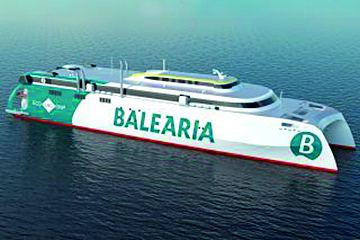
Baleària also revealed that this fast ferry will be christened the Eleanor Roosevelt (above), author and promoter of the Universal Declaration of Human Rights and a gender equality activist.
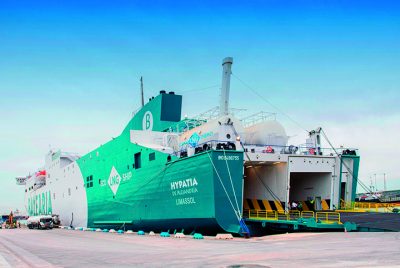
On the evening of 30th January 2019, the Hypatia de Alejandría, the first LNG-propelled ferry on the Mediterranean, entered service on the Barcelona-Palma route (above).

The company’s 24,409gt/2002 built Ro-Pax Napoles was in Gibraltar in January/ February to have her engines converted to LNG fuel (above).

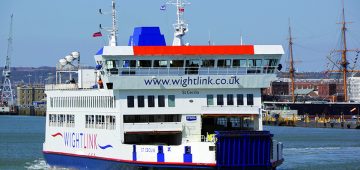



Comments
Sorry, comments are closed for this item